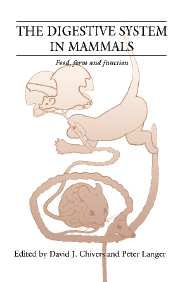24 - Food, form and function: interrelationships and future needs All contributors (operating in three groups)
Published online by Cambridge University Press: 18 March 2010
Summary
We have considered the spectrum of factors involved in food, form and function, and the interrelationships between them. Thus, diets, gut morphology and digestion are each classified in detail, in terms of the nature of foods, the mechanics of their processing in the mouth and the chemistry of their digestion in the alimentary canal. Attempts have been made to relate them to each other and to indicate future directions for research. The aim in this concluding chapter is to synthesise the results of these deliberations as they have developed during the production of this book.
This must be done in an evolutionary context: the integrating framework for the diversity seen among mammals with respect to any body system and its interaction with the environment. This should be especially true for the digestive system and the wide range of foods exploited by mammals in the whole range of available environments. The biomes of the world are characterised by floral and faunal associations that provide trophic resources with changing profiles of potential diets, so that many configurations observed today may not be typical of the past. Nutritional niches tend to be narrow because of constraints on the digestive systems, but some mammals, especially primates, exhibit a wide range of diets because of a relatively unspecialised digestive system. Much can be gained by comparing the adaptations of primates with the specialisations of other animals for eating either animal matter or foliage. For such reasons, we do not restrict our attention to mammals but try to put them into a broader vertebrate perspective, especially by comparisons with the great radiation of birds.
- Type
- Chapter
- Information
- The Digestive System in MammalsFood Form and Function, pp. 411 - 430Publisher: Cambridge University PressPrint publication year: 1994
- 1
- Cited by



